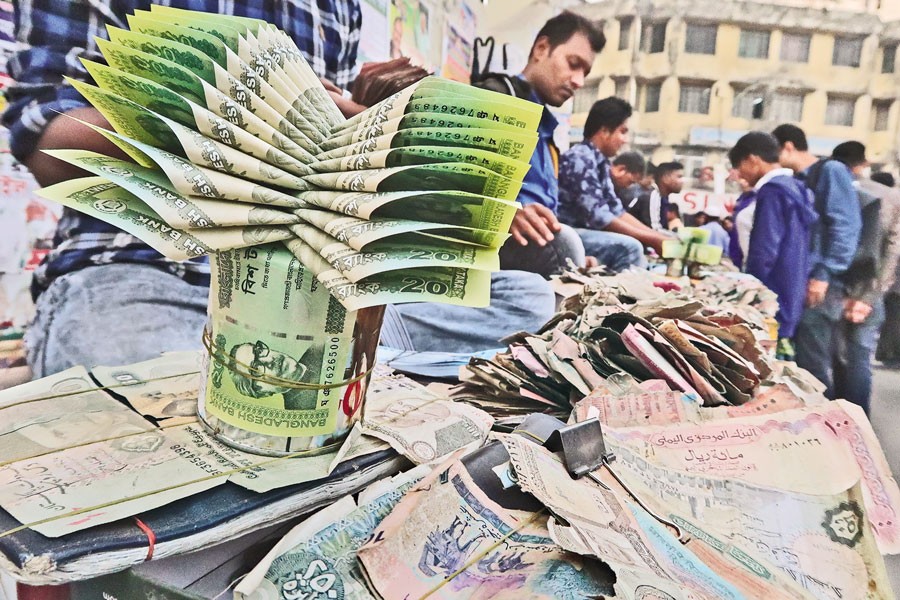
Cushions against the odds: Bangladesh economy
Muhammad Shahadat Hossain Siddiquee | Wednesday, 23 November 2022

 Odds to the global economy, including persistent inflation, supply chain disruptions, the continuing pandemic and Russia-Ukraine war, oil price hikes, and aggressive policy rate increases by the US Fed, are creating uncertainties in Bangladesh's economy.
Odds to the global economy, including persistent inflation, supply chain disruptions, the continuing pandemic and Russia-Ukraine war, oil price hikes, and aggressive policy rate increases by the US Fed, are creating uncertainties in Bangladesh's economy.
All these results in multidimensional challenges in the commodity and financial markets, trade flows, balance-of-payment, and, exchange rate. The annual inflation rate reached a near 11-year high of 9.52 per cent in August 2022, driven mainly by a passthrough of global commodity prices, depreciation of BDT against USD, and a 50per cent hike in fuel oil prices in Bangladesh in the same month. Particularly, people belonging to lower-income groups in rural areas are hardest hit due to the rise in food inflation. The recent fuel price hike may affect farmers due to the upswing in irrigation costs.
Sustaining growth in food grain production requires seriously addressing this issue, i.e., keeping the diesel and fertiliser prices low through subsidy and ensuring the availability of fertiliser and its distribution throughout the country without disruptions. This would help enhance the supply- and production activities undertaken by the Central Bank, tackling inflationary pressures.
In this regard, the central bank should also adjust the interest rate in line with the inflation rate and manage the money supply within the country to tackle the ongoing inflationary pressures. Similarly, the Bangladesh government (from a fiscal stance) should increase the tax rates, leading to a decrease in individual demand and the economy's money supply. Moreover, efficient management of expenditure might help control inflation.
Despite a saving grace for Bangladesh's economy resulting from the post-Covid export recovery, a continuing gap persists in the trade account balance and even in the overall Balance of Payment (BoP). The underlying factors, including elevated commodity and energy prices, the trade deficit (import payments outstripped the export earnings), relatively moderate remittance inflows, repayment of foreign loans, etc., resulted in a surge in the current account deficit, which surpassed the surplus in the capital and financial account and created a large deficit in the BoP.
This has exerted depreciation pressures on the foreign exchange market; thus, Taka gets devalued, adding fuel to the fire of import inflation. As a cushion, Bangladesh Bank intervened in the foreign-exchange market by selling USD though insufficient to prevent the ongoing devaluation of BDT.
Moreover, the recent upward adjustment of energy and fertiliser prices on the domestic market and significant depreciation of the Taka (BDT) against the USD might deepen the cost-push shocks to the Bangladesh economy. Based on these facts, the Bangladesh government should require more social protection and other support measures for the marginalised and vulnerable segment of the population.
Though Bangladesh is less likely to face Sri Lanka-type situation, cushions against these odds to avoid external bankruptcy might include managing externally-financed projects more efficiently in terms of reducing cost and time overruns, preventing leakages and setting priorities over projects, attracting more foreign direct investment (FDI), preventing money laundering, limiting unnecessary and luxury imports, encouraging remitters to use formal channels, taking extra care of export-oriented industries and import-substitution industries would help minimise the stress on the BoP and stabilise the foreign exchange market.
Despite the heavy reliance of the economic development of Bangladesh economy on the banking industry, it has faced manifold hurdles in recent times, such as liquidity crisis, shortage of capital, non-performing loans (NPLs), inefficiencies, incompetency to make payment of imports LCs and so on. Such illnesses in financial sectors may deepen the crisis in the banking sector that people might expect.
It is evident that there is a downward trend in the liquidity in the banking sector throughout the fiscal year 2022-2023, resulting from partial sterilisation in the foreign-exchange market by the Central Bank and the private sector credit growth. This measure contributed to the decline in the foreign-exchange reserves and failed to stabilise the foreign exchange market. The downward trend of the liquidity in the banking sector also results from the declining trend of total deposits (i.e., which covers all deposits money at banks) over the past four successive months due to increased cost of living resulting from soaring commodity prices.
For example, in April 2022, total deposits reached an all-time high of 177.106 USD billion, whereas it declined to 165.359 USD billion in August 2022 (i.e., a 6.63 per cent decline in total deposits in August 2022 over April 2022). Despite the downturn in total deposits in the banking sector, credit growth to the private sector has shown an upturn in the last five months and reached a 45-month high of 14.07 per cent in August 2022. This is the resultant outcome of rising prices of USD and import commodities. Therefore, it is obvious that soaring commodity prices, banks' increased spending on USD purchases, and a rise in the credit flows to the private sector have been contributing to the drying up of liquidity in the baking industry. Considering the liquidity crisis in the banking industry, the government is reducing borrowing from the banks, while repaying previous loans taken from banks and increasing borrowing from the central bank.
As some banks' liquidity is already stressed, cash-strapped banks are borrowing from Bangladesh Bank. Moreover, problems faced by a few banks recently regarding the L/C payment may create public panic, which might exaggerate the complications.
A rise in non-performing loans and a decline in deposits are serious issues in the banking sector. Deepening such crises may hinder receiving credit from international organisations such as World Bank's International Development Association (IDA), IMF and ADB, etc. Central bank and the government should take care of these issues seriously to ensure stability in the financial sector of Bangladesh. Moreover, it is high time to withdraw the cap of 9per cent lending rate of banks as investors and people love to take loans at such a low fixed rate.
Last but not least, to maintain the increasing burden of servicing public debt resulting from increased deficit financing, the government should focus on increasing the tax-GDP ratio, which is unexpectedly low and has remained stagnant over the last three decades, to improve self-containment and reduce the burden on foreign currency, especially for the mega-projects.
Dr Muhammad Shahadat Hossain Siddiquee, Professor, Department of Economics, University of Dhaka.
shahadat_eco@yahoo.com